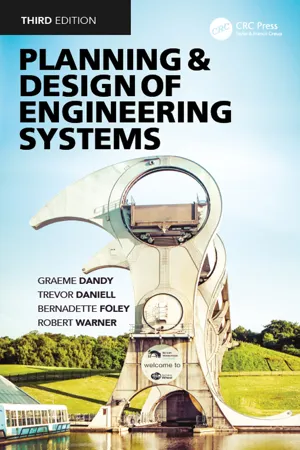Technology & Engineering
Modern Engineering
Modern engineering refers to the application of scientific and mathematical principles to design, develop, and improve structures, machines, systems, and processes. It encompasses various disciplines such as civil, mechanical, electrical, and chemical engineering, and often involves the use of advanced technologies and materials to address complex challenges and create innovative solutions for the modern world.
Written by Perlego with AI-assistance
Related key terms
3 Key excerpts on "Modern Engineering"
- Ruiyu Yin(Author)
- 2016(Publication Date)
- Academic Press(Publisher)
Science, technology, and engineering are involved, closely related but essentially different objects in engineering. For the three objects, only by distinguishing between the concept and method, combined with a clear understanding of their interrelation, can the correct engineering thinking be established.7.1.1.1 Engineering and Technology
In the history of human society development, engineering has had an organized, designed, and creative artificial existence. Engineering activity is a practical activity depending on nature and reforms nature to serve as a benefit for human beings, which is a collective activity. In the process of human history, engineering has been always directing productivity and the material basis of advancing society. It’s a technology flock (technology integrated system) gained by selecting and integrating relevant technology, analyzed from the characteristics of engineering. Technology is the core of engineering; meanwhile, engineering has to be a predictable and valuable artificial existence, interacting with economic elements (resource, land, capital, labor force, market, and environment etc.) under certain conditions.Technology is the process operation methods and skills that have accumulated and developed gradually through the practice of understanding and transforming nature for human beings. In general, the corresponding product tools and equipment are included as well. Both technology and engineering come from the subjective initiative of human beings, while their objectives are different. The objective of technology is relatively simple, and this is emphasized by the accumulation of work experience and the understanding of nature and its rules for the aim and in the process of changing the world. In the development process of technology, the social economic factors are considered as external factors, while they are treated as inherent factors for engineering. For example, the technology of semimolten state steelmaking-Wrought Steel (Yang, 2004 ) in metallurgical history is discussed. Wrought steel is a metallurgical technology. Antique excavation and historical documents show that the wrought steel technology was very exquisite in ancient China, for example, the “Hundred Refining,” “Fifty Refining,” “Thirty Refining,” and “Cofusion Process” (Yang, 2004- eBook - ePub
- Graeme Dandy, David Walker, Trevor Daniell, Robert Warner, Bernadette Foley(Authors)
- 2017(Publication Date)
- CRC Press(Publisher)
st Century.An updated and more general definition of the overall field of engineering was made in 1958 by the US Accreditation Board for Engineering and Technology: Engineering is … “the profession in which a knowledge of the mathematical and natural sciences, gained by study, experience, and practice, is applied with judgment to develop ways to utilize, economically, the materials and forces of nature for the benefit of mankind”.In this statement (quoted in Voland, 2004) the list of specific design skills has been removed and the theme of working for the benefit of mankind has been introduced. The idea of working economically has also been included. In fact, concepts of cost control and economic operation began to be used overtly in engineering work in the late 19th Century. These are important considerations in all Modern Engineering work, although when new, innovative techniques are being developed and used for the first time, the main problem may be to get the project completed successfully. A distinguished engineer has ruefully suggested that it is often better, financially, to be the second or third person to use a new, innovative process.In the middle of the 20th Century there were still five main engineering branches: civil, electrical, mechanical, chemical and mining engineering, but, following the Second World War, development was rapid in all fields of engineering and many new branches of specialisation appeared, and matured. Subdivisions of the traditional fields, and the appearance of completely new engineering disciplines, have continued to this day. The newer engineering branches flourishing towards the end of the 20th Century included aeronautical, aerospace, agricultural, automotive, biomedical, coastal, computer systems, electronic, environmental, mechatronic, medical, optical, rehabilitation, and transport engineering, to name but a few. The pace of engineering innovation and development has if anything accelerated into the 21st - eBook - ePub
Innovation Fundamentals
Quantitative and Qualitative Techniques
- Adedeji B. Badiru, Gary Lamont(Authors)
- 2021(Publication Date)
- CRC Press(Publisher)
7Innovation through Industrial Engineering Techniques
INTRODUCTION TO NEXUS OF INDUSTRIAL ENGINEERING AND INNOVATION
Innovation is not a physical product, but a mindset to find a better way to accomplish an objective. This is why we feel passionate about the application of the tools and techniques of industrial engineering, a profession dedicated to “finding a better way” to accomplish any objective. The objective may be along the realm of technology, process, and workforce improvement. Some of the pertinent definitions of industrial engineering include the following:Industrial engineers make systems function better together with less waste, better quality, and fewer resources.Below is the official definition from the Institute of Industrial and Systems Engineering:Industrial engineers deal with systems. They can design, implement or improve integrated systems comprised of people, materials, information or energy. Industrial engineering can develop a better way of doing just about anything.Industrial engineers find innovative ways to solve complex problems. In all spheres of organizational pursuits in government, business, industry, the military, and hospitals, industrial engineering makes things happen more efficiently.Industrial Engineer – one who is concerned with the design, installation, and improvement of integrated systems of people, materials, information, equipment, and energy by drawing upon specialized knowledge and skills in the mathematical, physical, and social sciences, together with the principles and methods of engineering analysis and design to specify, predict, and evaluate the results to be obtained from such systems.EVOLUTION OF INNOVATION IN SOCIETY
The diverse need of the society for innovation is the reason why industrial engineering is needed. This fact has been highlighted by various publications on industrial engineering over the years, including Emerson and Naehring (1988) , Zandin (2001) , Martin-Vega (2001) , Salvendy (2001) , Sink et al (2001) , Badiru and Thomas (2009)
Learn about this page
Index pages curate the most relevant extracts from our library of academic textbooks. They’ve been created using an in-house natural language model (NLM), each adding context and meaning to key research topics.


